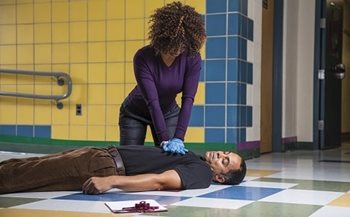If you witnessed an unexpected medical emergency, would you feel comfortable in immediately taking action to help? Many Canadians would not. There are many beliefs or myths that can and do stop people from helping another individual in distress, such as cardiac arrest.
In fact, seven out of 10 cardiac arrests happen in front of bystanders, however less than 20% of lay bystanders end up providing first aid.
An estimated 40,000 cardiac arrests occur outside of a hospital setting in Canada each year, with 80-85% of these cases happening in the home and the rest in a public setting.
Taking action when someone experiences cardiac arrest can significantly increase their chance of survival.
What to do
 Early CPR remains one of the most critical factors in surviving cardiac arrest. The basic steps when coming upon someone unresponsive and not breathing include:
Early CPR remains one of the most critical factors in surviving cardiac arrest. The basic steps when coming upon someone unresponsive and not breathing include:
- Get help – call 911 or your local emergency number to activate your local emergency medical system.
- Start chest compressions to keep the blood flowing.
Why people hesitate to act in an emergency
There are many reasons why bystanders are hesitant to get involved. Since it’s important to take action when someone is unconscious/not breathing, we’re debunking some common fears and myths that can make some people hesitate to perform first aid.
Myth: I’m not trained in First Aid/CPR so I don’t know how to help.
Fact: You don’t need to be a medical professional to help someone in cardiac arrest. First Aid training helps to make you feel comfortable and confident in administering first aid or CPR. If you don’t have first aid training, there are still many helpful qualities you have that can help in an emergency. Shout for help and immediately call 911 or your local emergency number. The responder on the line can help guide you on what to do.
Myth: Maybe it’s not serious. Maybe they just fainted.
Fact: If the person is unresponsive and not breathing normally, they have not fainted. This person will have a much better chance of survival if you begin chest compressions.
Myth: I can’t help because I don’t want to do mouth-to-mouth.
Fact: The Canadian Red Cross recognizes that compression-only CPR is an acceptable alternative for those who are unwilling, unable, untrained, or are no longer able to perform full CPR. Learn more about Compression-only CPR.
Myth: I don’t know how hard to push, I don’t want to hurt them.
Fact: All Canadian provinces and territories have legislation that protects those who voluntarily help in emergency situations from liability. Cracking of ribs can happen during CPR, but it's preferable to death. Call 911 or your local emergency number for help.
Myth: They need an AED but I don’t know how to operate the machine.
Fact: An AED (automated external defibrillator) comes with audio instructions to guide you through as you use it, so you just need to turn it on and follow its instructions.
Myth: Once I start CPR, I can’t stop.
Fact: People who are not health care providers can stop CPR when they are too tired to continue, when someone takes over for them, when professional help takes over or the when the scene becomes to dangerous to continue.
It’s natural to feel some hesitation in an unexpected emergency situation, but learning and practicing CPR and going through scenarios in a first aid/CPR course helps individuals to feel more comfortable and builds their confidence to respond and take action when help is needed.
Find a course near you and learn more at redcross.ca/firstaid.
Related:

